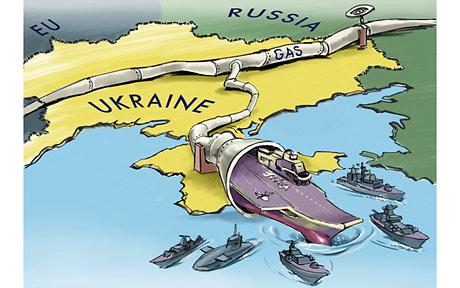It is some years that Russia has planned keep Ukraine out the gas delivery route to Europe. The previous years’ gas dispute taught Moscow and its European gas buyers that it is much better not to have anybody who could turn off the taps of the pipelines on their route to the final customer. The new crisis in Ukraine, now, seems to shuffle the cards.

Get rid of Ukraine
Siberian gas from the mighty Yamal reserve, already flows straight to Germany trough the Baltic Sea, completely bypassing Baltics and Poland. The Nordstream offshore pipeline was completed already one year ago, while its southern twin (the Southstream, crossing the Black sea, Bulgaria, Greece and plugging into the Italian heel), is on the way and is due to be completed by 2018. When both the pipelines will be in operation, no more gas directed to Europe will have to pass through Ukraine.
But the ongoing Russia-Ukraine crisis seems to have changed the scenario. Fears of a repeat of the 2009 gas dispute, when Russia cut off gas supplies to Ukraine, are spreading across EU countries that most depend on Russian gas. Bulgaria and the Baltics, as well as Finland and Sweden, depend exclusively on Russian gas, while others like Poland and Austria get up to 80% of their demand from Russia.
A mutual dependence
Moscow has frequently used gas to strong-arm his western neighbor, cutting off supplies or simply threatening to do it. Ukraine is served by a network of Soviet-era pipelines that transport more than half of Russia’s gas supply to the European Union. It is obvious that any interruption of the flow puts the region’s energy security at high risk.
Officials of the EU, according to the Wall Street Journal, say that there is now a strong will to reduce European dependence on Russian gas and the European Commission said that high-level talks on South Stream will have a stop.
“Clearly the commission is trying to punish Russia for what it has done in the Crimea”, said to the WSJ Julian Wieczorkiewicz, an energy researcher at the Centre for European Policy Studies, a think tank in Brussels. “The Russians are now more dependent on our money than we are on their gas. The EU could also explore ties to Norway, Algeria and Qatar as alternative suppliers, increase the use of coal and import LNG.”
Kiev’s role
Ukraine’s debt towards Russia’s gas monopolist amounts to 1.55 billion of unpaid bills. Gazprom could quit the agreement signed last year to supply Ukraine at a cheaper rate, unless the debt is paid. “It seems without payments for gas and fulfillment of commitments, Ukraine may not keep its current gas price discount”, Gazprom spokesman Sergei Kurpriyanov said. The agreement was negotiated in December by Yanukovych, right after the decision not to sign the Association Agreement with the EU. Ukraine’s new government cannot afford to meet Gazprom’s demand for payment as it is negotiating a $15 billion bailout with the International Monetary Fund. Ukraine uses more gas than France, more than half of which comes from Russia, and it is clear how this could affect the national policy.
Ukrainian pipeline network could in future become a rusty net of pipes, when all the bypasses will be completed. The Soyuz branch, passing through Kiev, will probably be used only for domestic demand, while minor branches will have little importance compared to the mighty streams of the Nordstream and the Southstream combined. But until the bypasses are done, eyes must be kept on a short piece of the southern branch of Druzhba pipeline linking to the Southstream terminal on the Black Sea and passing close to Lugansk in the eastern pro-Russian part of Ukraine. Right where new secessionist pressures are on the go.
It is some years that Russia has planned keep Ukraine out the gas delivery route to Europe. The previous years’ gas dispute taught Moscow and its European gas buyers that it is much better not to have anybody who could turn off the taps of the pipelines on their route to the final customer. The new crisis in Ukraine, now, seems to shuffle the cards.





